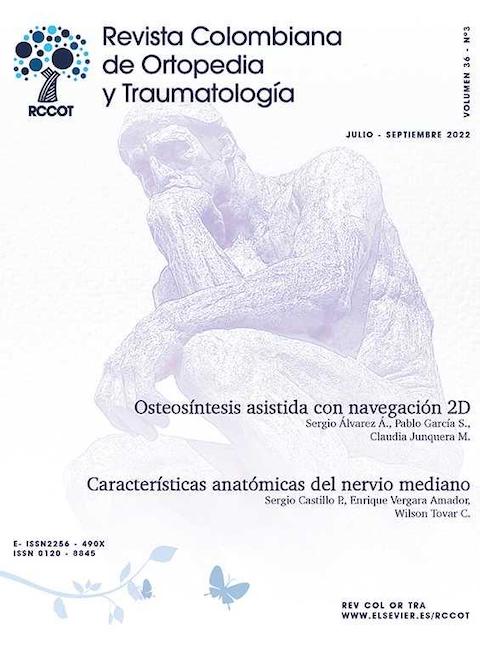2D computer navigation assisted iliosacral screw fixation in posterior pelvic ring injuries
DOI:
https://doi.org/10.1016/j.rccot.2022.06.009Keywords:
surgical navigation systems, pelvic bones, sacroiliac jointAbstract
Introduction: Percutaneous osteosynthesis of the sacroiliac joint guided by fluoroscopy in posterior pelvic ring lesions, described by Matta in the 1990s, remains the gold standard technique. However, the development of novel techniques such as 2D/3D navigation-assisted or CT-assisted surgery brings improvements in terms of ease and safety.Objective: To present the 2D navigation-assisted percutaneous sacro-iliac fixation technique, as well as the clinical and radiological results of the patients operated.
Materials and methods: Twenty-three patients with a diagnosis of posterior pelvic ring disruption (sacroiliac dislocation and/or fracture) operated by 2D navigation-assisted percutaneous fixation (Medtronic Synergy System) in our hospital from 2017 to present were reviewed. Demographic, classification, therapeutic variables and derived complications were collected. The modified POS (Multicenter Study Group Pelvis Outcome Scale) rating scale was used to assess clinical, radiological and social outcome.
Results: Eight patients had sacro-iliac dislocation and 15 had fracture through the sacrum. A total of 40 iliaosacral screws were implanted. The mean operative time was 20 min for each screw. An average of eight fluoroscopy pulses were required per procedure. There were three malpositioned screws (7.5%). Fifteen patients had good or excellent results on the POS form.
Conclusions: Navigation-assisted percutaneous iliaosacral fixation is an alternative to the classic method guided by radioscopy, with good results. It facilitates the surgeon the correct placement of the screws, shortening the surgical time and with less exposure to ionizing radiation. It is useful for all types of ring lesions and when reduction maneuvers are necessary.
Downloads
References
Forward D. Pelvic Ring. En: Buckley RE, Moran CG, Apivatthakakul T, editores. AO Principles of Fracture Management. 3a ed. Suiza: Thieme; 2017. p. 717-44, https://doi.org/10.1055/b-0038-160811
Routt ML Jr, Simonian PT, Agnew SG, Mann FA. Radiographic recognition of the sacral alar slope for optimal placement of iliosacral screws: a cadaveric and clinical study. J Orthop Trauma. 1996;10:171-7, https://doi.org/10.1097/00005131-199604000-00005
Miller AN, Routt ML Jr. Variations in sacral morphology and implications for iliosacral screw fixation. J Am Acad Orthop Surg. 2012;20:8-16, https://doi.org/10.5435/JAAOS-20-01-008
Matta JM, Saucedo T. Internal fixation of pelvic ring fractures. Clin Orthop Relat Res. 1989;242:83-97. https://doi.org/10.1097/00003086-198905000-00009
Behrendt D, Mütze M, Steinke H, Koestler M, Josten C, Böhme J. Evaluation of 2D and 3D navigation for iliosacral screw fixation. Int J CARS. 2012;7:249-55, https://doi.org/10.1007/s11548-011-0652-7
Ebraheim NA, Coombs R, Jackson WT, Rusin JJ. Percutaneous computed tomography-guided stabilization of posterior pelvic fractures. Clin Orthop Relat Res. 1994;307:222-8.
Zwingmann J, Südkamp NP, König B, Culemann U, Pohlemann T, Aghayev E, Scmal H. Intra- and postoperative complications of navigated and conventional techniques in percutaneous iliosacral screw fixation after pelvic fractures: Results from the German Pelvic Trauma Registry. Injury. Int. J. Care Injured. 2013;44:1765-72, https://doi.org/10.1016/j.injury.2013.08.008
Zwingmann J, Hauschild O, Bode G, Südkamp NP, Schmal H. Malposition and revision rates of different imaging modalities for percutaneous iliosacral screw fixation following pelvic fractures: a systematic reviw and meta-analysis. Arch Orthop Trauma Surg. 2013;133:1257-65, https://doi.org/10.1007/s00402-013-1788-4
Pohleman T, Gänsslen A, Schellwald O, Culeman U, Tscherne H. Outcome after pelvic ring injuries. Injury. 1996;27Suppl2:B31-8. https://doi.org/10.1016/S0002-9378(15)33150-1
Van den Bosch EW, van Zwienen CM, van Vugt AB. Fluoroscopic positioning of sacroiliac screws in 88 patients. J Trauma. 2002;53:44-8, https://doi.org/10.1097/00005373-200207000-00009
Templeman D, Schmidt A, Freese J, Weisman I. Proximity of iliosacral screws to neurovascular structures after internal fixation. Clin Orthop Relat Res. 1996;329:194-8, https://doi.org/10.1097/00003086-199608000-00023
Tasker AJB, Odutola A, Fox R, et al. Complications associated with the use of ilio-sacral screw fixation in posterior pelvic ring injuries. Injury Extra. 2010-12-01;41(Issue 12):151, https://doi.org/10.1016/j.injury.2010.07.459
Tonetti J, van Overschelde J, Sadok B, Vouaillat HA. Percutaneous ilio-sacral screw insertion Fluoroscopic techniques. Eid Orthopaedics & Traumatology: Surgery & Research. 2013;99:965-72, https://doi.org/10.1016/j.otsr.2013.08.010
Yu T, Cheng XL, Qu Y, Dong RP, Kang MY, Zhao JW. Computer navigation- assisted minimally invasive percutaneous screw placement for pelvic fractures. World J Clin Cases. 2020;8:2464-72, https://doi.org/10.12998/wjcc.v8.i12.2464
Matityahu A, Duffy RK, Goldhahn S, Joeris A, Richter PH, Gebhard F. The great unknown - A systematic literature review about risk associated with intraoperative imaging during orthopaedic surgeries. Injury. 2017;48:1727-34, https://doi.org/10.1016/j.injury.2017.04.041
Frane N, Megas A, Stapleton E, Ganz M, Bitterman AD. Radiaton exposure in orthopaedics. JBJB Reviews. 2020;8:e0060, https://doi.org/10.2106/JBJS.RVW.19.00060





